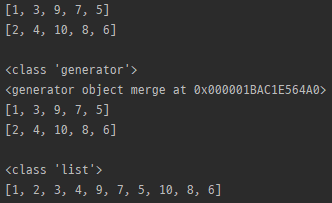728x90

힙 큐 (heap queue)
- 힙큐(heap queue) = 우선순위 큐 (priority queue)
- heapq에서는 요소를 0부터 세서, heap[k]의 left-child는 heap[2*k+1], right-child는 heap[2*k+2]이다.
>>> 1부터 만들면 편하지만, 파이썬은 0부터
- heapq의 heap은 기본적으로 최소힙(min heap)
- 기본적으로 list를 사용함
heaq 함수
| 함수 | 파라미터 | 설명 |
| heappush | heap, item | item을 heap으로 푸시 |
| heappop | heap | pop 하고 반환. 빈 힙이면 IndexError |
| heappushpop | heap, item | item을 push하고 가장 작은 항목을 pop (함수 두개 보다 효율적) |
| heapify | x | 리스트 x를 힙(min heap)으로 변환. return 값 없음 |
| heapreplace | heap, item | pop하고 push. 빈힙이면 IndexError |
| merge | *iterables, key=None, reverse=False | 여러 heap을 하나의 heap으로 merge. iterator 반환 - key : 입력 요소에서 비교 키를 추출할때 사용되는 키 함수 - reverse : 비교가 반대로 이뤄짐 |
| nlargest | n, iterable, key=None | n개의 가장 큰 요소를 리스트로 반환 - key : 예시로 key=str.lower 등.. |
| nsmallest | n, iterable, key=None | n개의 가장 작은 요소를 리스트로 반환 |
heapify, heappush, heappop, heappushpop, heapreplace
import heapq
myHeap = [5, 4, 6, 2, 8, 7, 1, 3, 9]
heapq.heapify(myHeap)
print(type(myHeap))
print(myHeap, end='\n\n')
print(heapq.heappop(myHeap))
print(myHeap)
heapq.heappush(myHeap, 10)
print(myHeap, end='\n\n')
print(heapq.heappushpop(myHeap, 11))
print(myHeap, end='\n\n')
print(heapq.heapreplace(myHeap, 12))
print(myHeap, end='\n\n')

- heapify는 반환값 X
- heappushpop, heapreplace 는 push와 pop을 따로 수행하는 것 보다 효율적
merge
import heapq
myHeap1 = [9, 7, 1, 3, 5]
myHeap2 = [10, 8, 2, 4, 6]
heapq.heapify(myHeap1)
heapq.heapify(myHeap2)
print(myHeap1)
print(myHeap2)
print()
myHeap = heapq.merge(myHeap1, myHeap2)
print(type(myHeap))
print(myHeap)
print(myHeap1)
print(myHeap2)
print()
myHeap = list(myHeap)
print(type(myHeap))
print(myHeap)

- merge는 heap에서 heap으로
- generator를 반환하므로 list로 바꿔줘야 함
nlargest, nsmallest
import heapq
myHeap = [1, 2, 3, 4, 5, 6, 7, 8, 9, 10]
print(heapq.nlargest(3, myHeap))
print(heapq.nsmallest(3, myHeap))
print(myHeap)

- 원래 heap은 건들지 않음. (pop 아님)
- nlargest는 내림차순으로, nsmallest은 오름차순으로 정렬됨
최대 힙 (max heap)으로의 응용
import heapq
myList = [1, 2, 3, 4, 5, 6, 7, 8, 9]
myHeap = []
# push
for n in myList:
heapq.heappush(myHeap, (-n, n))
print(myHeap)
# pop
print(heapq.heappop(myHeap)[1])

- tuple을 이용해서 거꾸로 정렬.
- 그냥 음수로 넣고 뺄때 부호 바꿔서 빼줘도 될듯
참조
- 파이썬 공식 문서
반응형
'Languages > Python' 카테고리의 다른 글
| [파이썬 101] string 외장 및 내장 모듈 (문자열) (0) | 2022.06.22 |
|---|---|
| [파이썬 라이브러리] itertools 모듈의 함수들 (0) | 2022.06.04 |
| [파이썬 101] all과 any (0) | 2022.06.03 |
| [파이썬 101] List, Set, Dictionary 연산과 메서드의 시간복잡도 (0) | 2022.06.03 |
| [파이썬 라이브러리] Collections 모듈의 deque (데크, 덱, 디큐, 데큐) (0) | 2022.06.03 |



